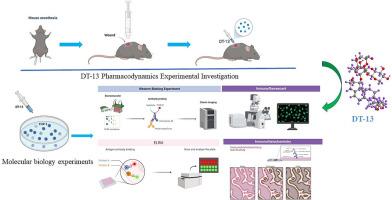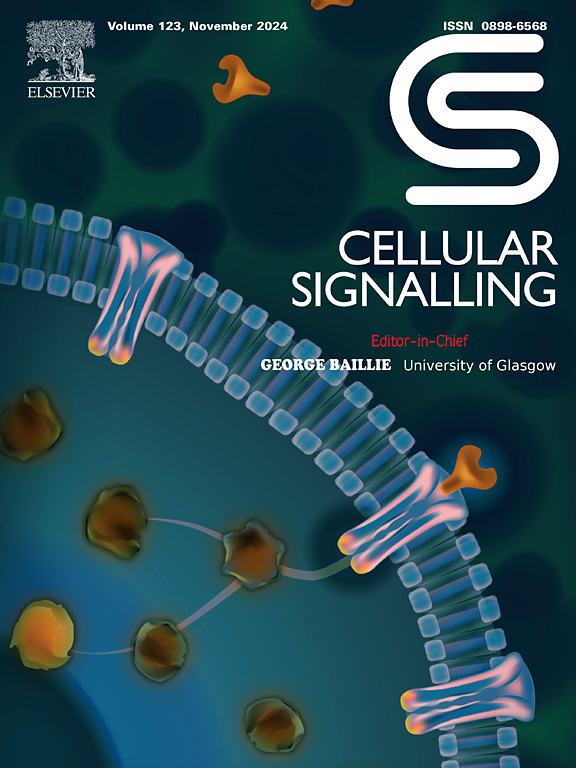DT-13 在糖尿病伤口愈合中调节巨噬细胞的机制。
IF 4.4
2区 生物学
Q2 CELL BIOLOGY
引用次数: 0
摘要
背景:糖尿病是一种复杂的代谢系统疾病,其难以治愈的主要原因之一是巨噬细胞无法实现从促炎M1表型向抗炎M2表型的转变。刺五加是一种传统中药。根据中医理论,刺五加具有滋阴生津、润肺清心的功效,用于肺燥干咳、阴虚咳嗽、咽喉关节痛、口渴、内热消渴、心烦失眠、肠燥便秘等症,属于补阴药的范畴。刺五加皂苷 C(DT-13)是刺五加的主要有效成分之一,具有显著的抗炎、抗肿瘤和免疫调节作用。本论文旨在探讨 DT-13 通过调节巨噬细胞的极化在血管生成中的作用,并最终通过调节免疫细胞在再生中发挥抗炎作用:我们利用糖尿病小鼠溃疡模型进行了体内实验,以验证 DT-13 在促进伤口愈合方面的作用。利用空间转录组测序技术对 II 型糖尿病小鼠和非糖尿病小鼠的伤口组织进行 RNA 转录本分析。随后,我们使用 CCK-8 试验评估了 DT-13 对 THP-1 细胞(人单核细胞)活力的影响。我们采用 ELISA、免疫荧光和 Western 印迹技术研究了 DT-13 抑制 LPS 诱导的 M1 巨噬细胞持续炎症和极化过程的机制。Transwell 试验用于评估 DT-13 处理对高糖条件下 LPS 诱导的 M1 巨噬细胞与 HUVEC 细胞共培养的影响。最后,应用小鸡胚胎绒毛膜(CAM)试验探讨了 DT-13 对 LPS 刺激下高糖条件下 M1 巨噬细胞刺激血管生成的影响:结果:我们发现 DT-13 能促进糖尿病溃疡模型小鼠的伤口愈合。通过空间转录组测序结果,我们发现 II 型糖尿病小鼠伤口处炎症水平较高,巨噬细胞特征蛋白表达异常。CCK-8 试验检测到 20 μmol/L 的 DT-13 对 THP-1 细胞有影响。通过 Q-PCR、ELISA、免疫荧光和 Western blot 检测结果,我们发现 DT-13 对高糖条件下 LPS 诱导的持续炎症的 M1 型巨噬细胞产生抗炎作用的机制可能是通过 TLR4-NFKB 信号通路,而诱导 M1 型巨噬细胞极化为 M2 型的机制可能是通过 ERK-STAT3 信号通路。有趣的是,通过 Transwell 试验,我们发现高糖条件下 LPS 诱导的 M1 型巨噬细胞经 DT-13 处理并与 HUVECs 共培养后,可提高 HUVEC 细胞的迁移能力。这表明,高糖条件下 LPS 诱导的 M1 巨噬细胞经 DT-13 处理后,可促进血管生成:结论:DT-13 能明显促进糖尿病小鼠伤口的愈合,其机制可能是通过改变巨噬细胞的极化参与促进血管的形成。本文章由计算机程序翻译,如有差异,请以英文原文为准。

Mechanism of DT-13 regulating macrophages in diabetic wound healing
Background
Diabetes is a complex metabolic system disease, and one of the main reasons why it is difficult to heal is that macrophages cannot realize the transition from pro-inflammatory M1 phenotype to anti-inflammatory M2 phenotype. Liriope spicata Lour. is a traditional Chinese medicine. According to the theory of traditional Chinese medicine, Liriope spicata Lour. has nourishing Yin Sheng Jin, moistening lung clear heart, used for lung dryness dry cough, Yin deficiency cough, throat arthralgia throat pain, thirst, internal heat thirst, upset insomnia, intestinal dryness constipation, is the classification of Yin tonifying drugs. Liriope muscari baily saponins C (DT-13) is one of the main active ingredients of Liriope spicata Lour., has significant anti-inflammatory, anti-tumor, and immunomodulatory effects.
This thesis aims to explore the role of DT-13 in angiogenesis by regulating the polarization of macrophages, and ultimately play an anti-inflammatory role in regeneration by regulating immune cells.
Methods
We conducted in vivo experiments using a diabetic mouse ulcer model to verify the effect of DT-13 in promoting wound healing. Spatial transcriptome sequencing technology was utilized to perform RNA transcript analysis on wound tissues from type II diabetic mice and non-diabetic mice. Subsequently, we used the CCK-8 assay to evaluate the impact of DT-13 on the viability of THP-1 cells (human monocytes). ELISA, immunofluorescence, and Western blot techniques were employed to study the mechanisms by which DT-13 inhibits the sustained inflammation and polarization process of M1 macrophages induced by LPS. The Transwell assay was used to assess the influence of DT-13 treatment on the co-culture of M1 macrophages induced by LPS under high glucose conditions with HUVEC cells. Finally, the chick embryo chorioallantoic membrane (CAM) assay was applied to explore the effects of DT-13 on angiogenesis stimulated by M1 macrophages under high glucose conditions with LPS stimulation.
Results
We found that DT-13 can promote wound healing in a diabetic ulcer model in mice. Through spatial transcriptome sequencing results, we discovered that type II diabetic mice had higher levels of inflammation at the wound site and abnormal expression of macrophage characteristic proteins. The CCK-8 assay detected that DT-13 at 20 μmol/L had an effect on THP-1 cells. Through Q-PCR, ELISA, immunofluorescence, and Western blot results, we found that the mechanism by which DT-13 exerts anti-inflammatory effects on M1 macrophages with sustained inflammation induced by LPS under high glucose conditions may be through the TLR4-NFKB signaling pathway, and the mechanism for inducing the polarization of M1 macrophages to M2 type may be through the ERK-STAT3 signaling pathway. Interestingly, through the Transwell assay, we found that M1 macrophages induced by LPS under high glucose conditions, after treatment with DT-13 and co-cultured with HUVECs, could increase the migratory ability of HUVEC cells. This indicates that M1 macrophages induced by LPS under high glucose conditions, after treatment with DT-13, can promote angiogenesis.
Conclusion
DT-13 can significantly promote healing wounds in diabetic mice, and its mechanism may be to participate in promoting the formation of blood vessels by changing the polarization of macrophages.
求助全文
通过发布文献求助,成功后即可免费获取论文全文。
去求助
来源期刊

Cellular signalling
生物-细胞生物学
CiteScore
8.40
自引率
0.00%
发文量
250
审稿时长
27 days
期刊介绍:
Cellular Signalling publishes original research describing fundamental and clinical findings on the mechanisms, actions and structural components of cellular signalling systems in vitro and in vivo.
Cellular Signalling aims at full length research papers defining signalling systems ranging from microorganisms to cells, tissues and higher organisms.
 求助内容:
求助内容: 应助结果提醒方式:
应助结果提醒方式:


